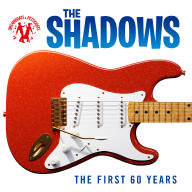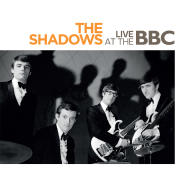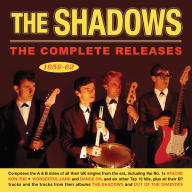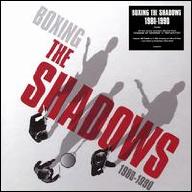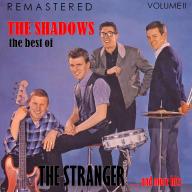The band's roots go back to Cheshunt, Hertfordshire, in early 1958, when a young Indian-born singer/guitarist named Harry Webb joined with drummer Terry Smart and guitarist Norman Mitham to form a group that they ended up calling the Drifters. At the time, none of the records by the American R&B group of the same name, founded by Clyde McPhatter, had been released in England, so they had no inkling of the name's already being used. The band played their first performance in March 1958 at a dinner dance and, after a few weeks of local performances, they debuted at the 2I's coffee bar in London's Soho. The 2I's was renowned as the venue where Tommy Steele had been discovered, and was occasionally visited by producers, recording engineers, and managers in search of new talent; it had, thus, become something of a rock & roll mecca.
The Drifters weren't signed overnight, but they did become immensely popular, playing some very convincingly American-style rock & roll, at least by the standards of the time in London. Indeed, at their shows, audiences were usually packed in too closely to dance, and the ten pounds they made each week between them in the beginning was serious money for three amateur musicians. In the course of their 2I's gigs over the next few weeks, the group picked up one fan, John Foster, who became their first manager, and another, Ian Samwell, who joined them as a guitarist. Interestingly, they had no bassist in their lineup and didn't for quite a while, which set them apart from other bands but didn't seem to impede their progress.
The first of two name changes came up when the combo got an outside booking in Derbyshire; at that point, Foster decided that "the Drifters" wasn't impressive enough as a name by itself, and wanted their vocalist to have lead billing. At that point, as the singer observed 40 years later, "[Harry Webb] didn't sound very rock & roll." And so, after some pondering of the possibilities, he picked up a stage name, Cliff Richards, with Samwell recommending that the "s" be left off, and Cliff Richard the Drifters were born. A little more than 40 years later, he was Sir Cliff Richard.
By that time, the group was a quintet of Richard (who still played guitar as well as singing, in the early days), Mitham, Samwell, Ken Pavey (on third guitar), and Terry Smart -- and still no bassist. This five-man group recorded a demo in June 1958, of "Breathless" b/w "Lawdy Miss Clawdy," which found its way to Norrie Paramor, a producer at EMI, who, after seeing them in an audition, signed Richard to the company's Columbia label. In July 1958 the group, augmented by session guitarist Ernie Shaw playing lead and Frank Clarke on bass, backed Richard on his debut single, "Schoolboy Crush" b/w "Move It," credited to "Cliff Richard the Drifters." The A-side was a pleasant, loping slow-tempo piece of teen pop/rock worthy of Fabian at his wimpiest, but "Move It" -- authored by Ian Samwell, no less -- was a pounding, driving rocker in the best Elvis Presley manner. Fortunately for all concerned, the record was "flipped" and "Move It" became the A-side. The record, released in late August, reached number two on the charts, and as it was climbing the listings, Cliff Richard began a series of appearances on the television show Oh Boy! in mid-September. All of these events -- the recording contract, the single, the chart placement -- ensured Richard's emergence to stardom, but the Drifters, at first, were another matter. Although he was willing to use the band on Richard's recordings, Paramor already felt compelled to use session musicians to enhance their sound in the studio, and as their audience grew along with the demand for shows in bigger and more competitive venues, it was clear that the group would have to adapt.
It was John Foster who, in the summer of 1958, went to the 2I's in search of a Liverpool guitarist and singer he'd heard about named Tony Sheridan. He wasn't there, but Foster did find a pair of virtuoso guitarists named Hank Marvin and Bruce Welch; they were already members of a top skiffle group called the Chesternuts and had made a couple of records. By September 1958, Mitham and Pavey were gone from the band, replaced by Marvin and Welch. With a lineup of Richard, Marvin, Welch, Samwell, and Smart, they proceeded to play before crowds that were completely unprecedented for a homegrown British rock & roll band. Richard also abandoned his guitar, just as Elvis Presley had, and found the experience liberating, as his stage moves became all the more intense and downright provocative, so much so that they were regarded as highly controversial in the press. The shows filled up and the bookings and the fees skyrocketed. Their sound was still a bit raw on-stage, but even that worked to their advantage at the time, giving the music still more authenticity than was typical for the time in England.
For that first year, the music was pure rock & roll on-stage and in the studio. The group's sound was toughened further in November when Ian Samwell dropped out of performing in favor of further cultivating his songwriting (which served him in good stead, along with producing, for the rest of his life). He was replaced by Jet Harris, who became the first stylistically important and notable rock & roll bassist in England, and almost single-handedly popularized the electric bass in British rock & roll. A second hit, "High Class Baby," made it to number seven in December 1958, and a follow-up, "Livin' Lovin' Doll" b/w "Mean Streak," reached the Top 20 in January 1959. In early 1959, Tony Meehan, a drummer who was already making a good living in his mid-teens as a session musician, replaced Terry Smart, the last of the original Drifters. This was the version of the group that was finally signed in their own right to EMI. An album followed in February 1959, cut live before an audience of extremely fervent fans at Abbey Road's Studio No. 1, which was issued under the title Cliff.
The Drifters name was changed to the Shadows in mid-1959 to avoid a conflict with the American R&B group, who had experienced a resurgence of popularity and whose records -- starting with "There Goes My Baby" -- were getting issued in England. The newly rechristened Cliff Richard the Shadows dominated British rock & roll for the next four years. Beyond Richard's fame, Marvin, Welch, Harris, and Meehan all became stars in their own right, with Harris and Meehan regarded as one of the best rhythm sections in the business, with a huge fan following of their own, while Marvin and Welch were directly responsible for the sales of tens of thousands of electric guitars to teenagers. A story out of the early history of the Beatles illustrates their dominance: John Lennon and Paul McCartney, both in their mid-teens at the time, knew that Richard and the Shadows were to appear on television one evening, and both were watching from their respective homes to look at Hank Marvin to see exactly how the intro to "Move It" was played. There was an effort early in 1959 to push Richard as a star in his own right, separate from the band, but it didn't come from the music side of the entertainment business; rather, he was signed to play an important supporting role in the gritty juvenile delinquency drama Serious Charge. Later that same year, he and the Shadows were all seen in the comedy/drama Expresso Bongo, essentially playing dramatizations of themselves.
Practically overnight in the fall of 1958, the Drifters-cum-Shadows had become the top rock & roll band in England, a status they maintain even as Richard's singing career was gradually steered toward more mainstream pop and ballads. The band began to emerge as a recording act on their own while they were still known as the Drifters, in January 1959, with the single "Feelin' Fine," a group vocal effort, the B-side of which, "Don't Be a Fool with Love," even featured them doing Belmonts-style harmony singing. A second single, "Jet Black" b/w "Driftin'" (still credited to the Drifters), was released in July of that year. And a third record, "Saturday Dance" b/w "Lonesome Fella," credited to the Shadows, and featuring vocals, was released in late 1959. All three were ignored by the public.
Then, in June 1960, the band recorded "Apache," an instrumental composed by Jerry Lordan that had previously been done by guitarist Bert Weedon -- and it topped the charts, riding the number one spot for five weeks. Over the next three years, they charted high with the singles "Man of Mystery," "F.B.I.," "The Frightened City," "Wonderful Land," and "Kon Tiki," the latter two reaching number one. All of these records showed phenomenal evolution in the group's sound from their rock & roll origins; mixing electric and acoustic guitar sounds in a unique meld, they were catchy, memorable, hook-laden pop masterpieces, some with a hard rock edge but more often showing a unique level of precision for the work of a rock & roll outfit. "Wonderful Land" also demonstrated a special command of orchestral timbres in juxtaposition with electric instruments. The group's influence during this period can be measured not just by their chart success, but their obvious influence on other artists. Sweden's Spotnicks, who became stars in their own right, emulated the Shadows' instrumental sound, and the Beatles, in their earliest official recording sessions (backing Tony Sheridan), in Hamburg, Germany during 1961, were allowed to cut a pair of songs of their own and gave one of those slots to a John Lennon/George Harrison-authored instrumental called "Cry for a Shadow," which was both a tribute and a gentle send-up of the Shadows' style.
The Shadows had also developed a stage presentation behind Richard in which they did little steps in unison. It seems incredibly hokey in retrospect, but one must remember that in the late '50s and early '60s, rock & roll in England was thought of as just another part of "show business" and entertainment, and the idea of dressing up the act with little contrivances wasn't so bizarre in that context. Other groups of the time, seeking success, emulated them -- and you can see the movie A Hard Day's Night poking fun at the band choreography, when the Beatles are clowning in the TV studio. On a more obscure but equally telling level, in the rock & roll/juvenile delinquency drama Some People (1962), directed by Clive Donner, one can see the members of the Bristol-based rock & roll band at the center of the movie running through the title song and suddenly start to do choreography that parodies the Shadows' stage moves.
In the fall of 1961, Tony Meehan left the band, owing to his unhappiness at the constant touring, and was replaced by Brian Bennett, another 2I's veteran, who had previously played with the house band on Oh Boy! and been a member of both Marty Wilde's and Tommy Steele's backing bands. Six months later, Jet Harris left the group, to be succeeded by Brian Locking (aka Licorice Locking), another 2I's alumnus. These lineup changes were major events in the British music press at the time, and there was some question as to whether the Shadows could hold on to their audience -- especially when Harris and Meehan teamed together for a recording, "Diamonds," that bumped the Shadows' then-current record from its chart position.
After a short transition period, however, the band found their popularity just as great as ever, and a string of hits followed across 1962 and beyond: "The Savage," "Guitar Tango," "Dance On," "Foot Tapper," "Atlantis," "Shindig," and "Geronimo." All of those made the Top Ten, with four placing at number one, through the end of 1963, carrying their success into the midst of the rise of the Beatles and the Liverpool sound. The group's first two LPs, The Shadows (1961) and Out of the Shadows (1962), both topped the album charts as well, and their next three long-players, Greatest Hits (1963), Dance with the Shadows (1964), and Shadow Music, all made the Top Five (the first two at number two). They also continued to appear on-stage with Cliff Richard and played on most of his biggest hit records of the period.
Locking was gone by 1964, replaced by John Rostill, inaugurating the longest-lasting lineup in the group's history, with Marvin, Welch, Rostill, and Bennett comprising the Shadows from 1964 until 1973, when Rostill's death eliminated the permanent bassist's spot. From then on, the Shadows would emulate Roxy Music by employing bassists rather than taking them on as ongoing members. Their success was the envy of a lot of musicians, though they were never able to successfully crack the American market as anything more than a cult act; indeed, on that side of the Atlantic, they tended to be thought of in the same vein as the Ventures, who came along at roughly the same time in the late '50s and have endured at least as long.
The Shadows -- often referred to informally as "the Shads" by their fans -- officially disbanded in 1968, on the tenth anniversary of their signing to EMI. Bennett devoted himself to a second career as a producer and arranger, while Marvin and Welch formed a Crosby, Stills Nash-type trio with John Farrar in the '70s, with harmony vocals to match. In spite of some gorgeous recordings, though, they were never able to leave the Shadows legacy behind, and by 1973, the group had been officially reactivated with Farrar as a member. The band remained active throughout the '70s and '80s, switching to the Polydor label with the start of the latter decade and still selling large numbers of records and CDs, as well as concert tickets in England and around the world. Marvin embarked on a solo career in 1990, which left the Shadows inactive for the next decade or so. But they reunited in 2004 for a series of farewell concerts that ended up being extended into the following year, and yielded a live album and a concert DVD.
Their farewell was a little premature, as -- following on from a December 2008 Royal Variety Performance -- the Shadows reconvened with Richard for 36 shows, reaching U.K. arenas and beyond, to celebrate the 50th anniversary of their earliest recordings. September 2009's accompanying album, Reunited, hit number four in the U.K albums charts and included "Singing the Blues," their first single together in 40 years. Aside from recording "The Appointment" for Bennett's 2015 album Shadowing John Barry, the following decade was quiet in terms of Shadows activity. However, in 2020, to mark 60 years since the release of "Apache," they recorded a new version of the track for the BBC4 documentary The Shadows at Sixty. ~ Bruce Eder, Rovi



